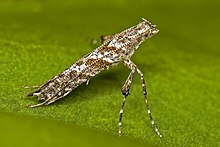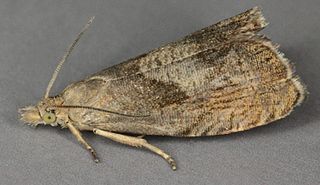
Dichrorampha simpliciana is a moth of the family Tortricidae. It is found in Europe and the Near East.

Piniphila bifasciana is a moth of the family Tortricidae. It is found in Europe and across the Palearctic to Japan.

Cydia fagiglandana, the beech moth, is a moth of the family Tortricidae.

Acylita distincta is a species of moth of the family Noctuidae first described by E. Dukinfield Jones in 1908. It is found in Brazil. Its wingspan is about 26 mm.

Parornix anglicella is a moth of the family Gracillariidae found in Asia and Europe. It was described in 1850, by the English entomologist Henry Tibbats Stainton, from a specimen from Lewisham, Kent.

Caloptilia populetorum is a moth of the family Gracillariidae. It is found in most of Europe, except Italy, the Balkan Peninsula and the Mediterranean islands.

Sphenarches zanclistes is a moth of the family Pterophoridae that is found in Australia.

Ochsenheimeria taurella, the Liverpool feather-horn or the rye stem borer, is a moth of the family Ypsolophidae.
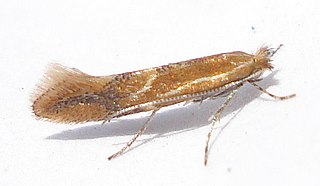
Phyllonorycter corylifoliella, the hawthorn red midget moth, is a moth of the family Gracillariidae. It is found in all of Europe.

Phyllonorycter quercifoliella is a moth of the family Gracillariidae. It is known from all of Europe, except for the Mediterranean islands.

Parornix devoniella is a moth of the family Gracillariidae found in Europe. The larvae are leaf miners, feeding on the tissue inside the leaves of hazels Corylus species.
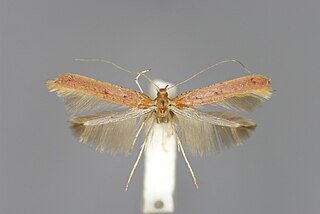
Caloptilia elongella is a moth of the family Gracillariidae. It is known from all of Europe east to eastern Russia. It is also found in North America from British Columbia, south to California and east in the north to New Hampshire and New York.

Caloptilia falconipennella is a moth of the family Gracillariidae. It is known throughout all of Europe, except the Balkan Peninsula.

Elachista obliquella is a moth of the family Elachistidae found in Europe.

Bryotropha domestica is a moth of the family Gelechiidae. It is found from Ireland to Germany, Slovakia, Romania and Bulgaria and from the Benelux to the Iberian Peninsula, Sicily, Crete and Cyprus. It is also found in Morocco, Algeria, Tunisia, Libya, the Middle East, Turkmenistan, Saudi Arabia and Yemen.

Bucculatrix ulmella is a moth of the family Bucculatricidae. It is found in most of Europe, except the Iberian Peninsula, Slovenia and Bulgaria. It was first described in 1848 by Philipp Christoph Zeller.

Ichneutica pelanodes is a moth of the family Noctuidae. It is endemic to New Zealand and has been found in scattered locations in the North, South and Stewart Islands. I. pelanodes is easily confused with I. skelloni as the two species are visually extremely similar. In the North Island though the range of the two species appears not to overlap. Generally of the two species I. pelanodes tends to be darker in appearance. I. pelanodes inhabits wetlands but the life history of this species is unknown as are the host species of its larvae. Adults are on the wing from October to February and are attracted both to sugar and light traps.

Eucosma cana, the hoary bell, is a species of moth of the family Tortricidae.
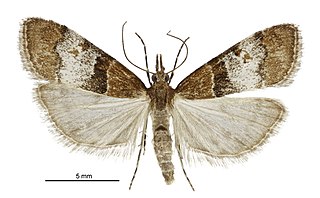
Antiscopa acompa is a moth in the family Crambidae. It was first described by Edward Meyrick in 1884. It is endemic to New Zealand and is found both the North and South Islands. The species inhabits native forest and adult moths are attracted to light.

Ichneutica paracausta is a moth of the family Noctuidae. This species is endemic to New Zealand. It is found locally in the central North Island, is widespread in the South Island and can also be found in Stewart Island. I. paracausta is variable in colour, but as it has a distinctive black streak on its forewing as well as a wing pattern that is characteristic, I. paracausta is unlikely to be confused with other species. It is present on the North Island volcanic plateau as well as Little Bush Reserve in Hawkes Bay in the North Island as well as in tussock grassland, alpine and subalpine shrubland and in alpine forest. Larvae have been recorded as feeding on grasses, a pupa has been found in a cocoon under the bark of a tree and adult moths are on the wing from October to January.
